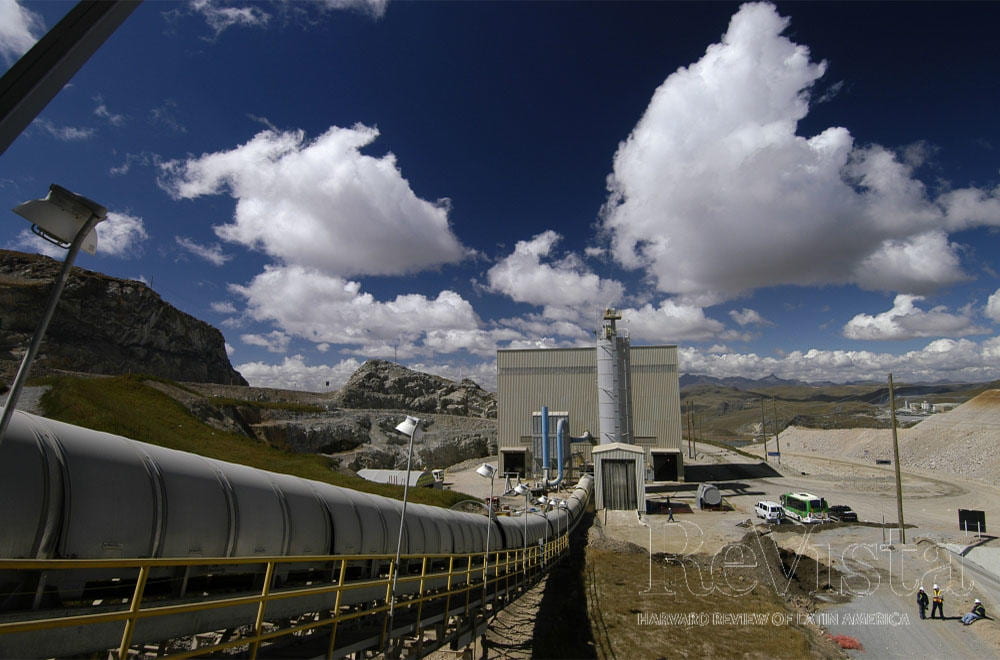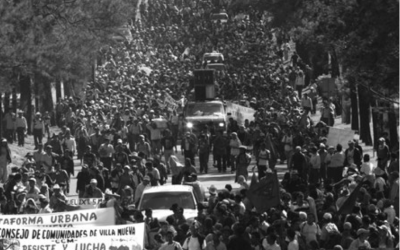Mining and Economic Development in Peru
A Time of Resurgence

An overview of a Barrick mining project in Lagunas Norte in La Libertad, Peru (Lagunas Norte and LN Faja Trans). Photo courtesy of Barrick Mining
Over the last decade, Peru has become one of the most successful economic performers in the developing world, registering average growth rates above 6 percent a year. The resurgence of mining, at a time of high metal prices, has been one of the key drivers behind the country´s stellar growth record. Peru’s experience shows that—contrary to the conventional “resource curse” assertions that rich natural resource endowments bring about economic stagnation, corruption and authoritarianism—it is possible to transform mineral wealth into sustained development with broad and significant welfare improvements for large segments of the population. Far from being a curse, mining has been a blessing for Peru.
Peru has experienced high economic growth while reducing poverty in half (currently less than 26 percent of the total population) and improving income distribution. According to the Inter-American Development Bank, more than half the population now belongs to the middle class. This contrasts sharply with previous episodes of short-lived economic expansion. The significance of Peru’s transformation becomes all the more dramatic when one considers that not too long ago, in the late 1980s, the country was mired in hyperinflation and threatened by a bloody internal conflict waged by two extremist terrorist organizations. I still remember, while pursuing my doctoral studies at the University of Chicago, reading academic accounts that described Peru as a quasi-failed state. Close to a million young Peruvians left the country in search of a better future abroad, discouraged by the deteriorating living conditions and rampant unemployment. The turnaround experienced by the country since then has been extraordinary.
The implementation of successful economic stabilization and structural adjustment policies in the early 1990s created the conditions for rapid growth. However, it was mining that facilitated this resurgence, attracting the first large investment projects that generated the income needed to fuel continued economic expansion. This consolidation of mining as an engine of growth has to be viewed against the backdrop of the country’s long tradition of metallurgy, dating back to pre-Columbian times. In 2011, Peru was the world’s second largest producer of copper, silver and zinc, and the sixth largest producer of gold. Not surprisingly, most large mining multinational corporations have a presence in the country. I worked for one of them, the Antamina Mining Company, a consortium formed by Teck, BHP Billiton, Xtrata and Mitsubishi. When it was first developed, Antamina became the largest green-field mining project in the world.
The importance of mining to Peru cannot be overstated. It accounts for close to 14 percent of the country’s GDP, and around 60 percent of exports. Its relative economic weight has expanded over the last decade, leading some critics to argue that the current mining boom has deepened the country’s dependence on primary resources and crowded out other productive activities. The evidence shows, however, that domestic industrial production has broadened and gained in complexity. Equally important, measured in volume terms, non-traditional exports tripled their size over the last decade, outpacing the volume growth of mineral production. Nevertheless, because the price of minerals reached historical heights due to skyrocketing Chinese demand, the relative participation of mining in the country’s total export bill has grown significantly.
Mining has become a magnet for foreign direct investment (FDI) as well. In 2012, the inflow of FDI reached a total of US$12.2 billion, with mining representing the main share (US$8.5 billion). The pipeline of planned investments, including the expansion of existing operations, and the development of new mines, many of which have secured the approval of Environmental Impact Assessments (EIAs) and other authorizations, could top US$53 billion by 2020. The implementation of these initiatives would more than double the current production of copper and multiply by six the output of iron ore. These projects could increase exports by $30 billion and generate over two million additional jobs. Due to the enhanced interconnections between mining and other local industries, each additional $1 billion in mineral exports could lead to an increment of close to $1.5 billion in GDP.
Mining also claims an important place when it comes to fiscal resources (15 percent of total government income collected in 2012). The central administration transfers half of the taxes collected from the industry to the regions and municipalities where the minerals are extracted. The “mining canon,” as this mechanism is known, is an important way to make Peru less centered in Lima. This decentralization effort is a process that seeks to give power and administrative functions to elected authorities at the local and provincial levels. The income sharing system was put in place so that localities and communities around mining centers would benefit more from the resources generated by the industry. The expectation was that these governments would invest the income in basic infrastructure and thus improve living conditions in the highland areas where mineral extraction takes place.
As a result of the current bonanza, the yearly funding provided to regional and local administrations grew from S/81 million to S/4.5 billion (soles) in 2001-2012. Unfortunately, these increased flows have not been accompanied by a strengthening of local capacities. Consequently, these authorities have proved unable to manage the windfall revenues, with large balances remaining unspent in bank accounts. Execution of investment budgets in regional governments and municipalities with a mining presence averaged 60 percent in 2011. Furthermore, in many cases, authorities have prioritized projects with low social returns such as the construction of soccer stadiums and ornamental plazas.
The future of mining will hinge not only on the evolution of global demand, but, more importantly, on what happens with the wave of social conflicts and community opposition that has engulfed many mining projects. According to the Peruvian Ombudsman Office, active social conflicts have tripled over the last five years. Of the total 148 socio-environmental conflicts identified, seven out of every ten are mining-related. Several studies show better socio-economic indicators for populations in mining districts than for their counterparts in similar areas where extractive industries are absent, but social conflicts in the former have been rising. The causes of these phenomena are complex and multifaceted.
Conflicts in mining areas often express environmental concerns, mostly about water usage and quality—even though “new mining” conforms to very demanding environmental standards, in stark contrast to informal and illegal extractive operations prevalent in many areas of the country. Other conflicts revolve around compensation for land purchases and relocations, perception of unmet commitments, or demands for the implementation of infrastructure projects not provided by local governments. In the negotiations that I have been involved with in Ancash, disputes focused on very specific issues. In other areas, however, conflicts have become heavily politicized. Last year, a wave of protests and strikes in Cajamarca, in the northern highlands, brought about the suspension of the US$4.8 billion Conga gold mining project. Similar mobilizations have affected other mineral producing regions, threatening to hinder the execution of many promising projects.
The absence of strong institutional channels to mediate between communities and mining companies has also contributed to the existing wave of conflicts. The Ombudsman’s office is one of the most respected public organizations, but its scope, resources and outreach capacity are limited, since it only intervenes after disputes have already escalated. No effective system now exists to identify and prevent potential conflicts. The absence of legitimate and mutually accepted mediation mechanisms means that companies and communities are left to sort their differences on their own. When authorities intervene, it is usually to establish “dialogue tables” after violent mobilizations have already occurred.
The persistence of deficits in key social services such as water and sanitation, amid an unprecedented fiscal bonanza, has aggravated frustrations among local communities, further fueling conflicts. The lack of managerial capabilities to efficiently administer windfall resources at the local level will have to be addressed in order to temper the current wave of conflicts. To that end, it is critical to strengthen human capital in local administrations, and put in place a system of incentives to recruit and retain competent managers in key posts. The solution to the problem goes beyond the provision of training, and entails other structural measures, such as improved remuneration scales and the overhaul of the public administration system (a recently launched measure). It is also important to align local investment decisions with national priorities to bolster the impact of social policy interventions at the local level.
Corruption can be a problem that further exacerbates conflicts, as public resources that would otherwise be available for social investments are redirected for personal gains. Earlier this year, the former mayor of San Marcos in the Ancash region, one of the local governments that benefits most from canon transfers, was arrested after leaving town with a stash of cash from the municipal coffers. The city has had three different mayors in fewer than two years, with the first two fired because of nepotism charges. According to national surveys, corruption is widely considered one of the main problems affecting the country.
In 2010 Peru became the first country in the Americas to join the Extractive Industries Transparency Initiative (EITI), which commits companies operating in the country to make public all tax and royalty payments to the government, with an independent audit certifying the validity of the information provided. Companies have successfully completed two rounds of reports with very minor discrepancies. To further advance the cause of transparency, it would be important to also require local administrations to provide details of canon expenditures and submit them to independent external audits.
More recently, the administration of President Ollanta Humala has implemented several measures aimed at diffusing tensions and enhancing the legitimacy of the environmental oversight process. Last year it established the National Environmental Certification Service (SENACE), formally charged with approving all Environmental Impact Assessments for extractive industries. Previously this role was assigned to the Ministry of Mines, which was also responsible for the promotion of mining investments. The government has also approved the regulation of the Prior Consultation Law, a piece of legislation aimed at providing indigenous communities with an enhanced voice on administrative processes, including those linked to natural resource projects. The outcome of the consultation is non-binding, as the government maintains the right to make final decisions.
Mining companies have also made important efforts to improve their relationships with communities, assuming a more open and constructive approach in their interactions with local groups. They have strengthened social responsibility programs and enhanced contributions to the economic development of communities where they operate. One example is the Antamina Mining Fund (AMF), to which the company contributed 3.75 percent of its profits in 2006-2011, as part of a broader industry commitment arranged with the central government. The AMF implemented programs that effectively reduced chronic child malnutrition, improved quality of schools, broadened access to basic health services, and assisted local governments in improving the local public infrastructure in Ancash. These projects were carried out through partnerships with local NGOs and other national and international organizations.
The recent slowdown of the Chinese economy has translated into lower mineral prices. Not surprisingly, this more restrictive international environment has negatively affected the Peruvian economy, now expected to expand at 5.6 percent instead of the 7 percent projected earlier in the year. In this new environment, the industry’s tax payments have also plummeted. During the first half of the year, canon transfers to the regions have contracted close to 30 percent. The resulting fiscal austerity has become another source of tensions in mining areas, where local authorities have begun to mobilize, this time against the central government, demanding that the full transfers be restituted despite the drop in mineral prices. Many of the local governments that were hostile to the industry are now demanding that the national government provide additional resources to cover the gap left by lower mining canon transfers.
Despite the recent downturn in prices, mining could continue contributing significantly to Peru’s rapid economic growth, helping to bring about poverty reduction and improvements in the welfare of large segments of the population. Peru has a unique opportunity to transform its rich mineral endowment into sustainable development. However, to do so, it will need to successfully manage the complex challenges posed by the social conflicts currently affecting some of its most promising mining projects.
Winter 2014, Volume XIII, Number 2
Pablo de la Flor is a specialist in Public Policy. He was Vice Minister of Trade and led the negotiations of the FTA with the United States. He has worked in the mining and finance industries and has been a consultant to several international development agencies and multilateral organizations. He holds an MPA from Harvard’s Kennedy School of Government and an MA in International Relations from Yale. He completed his doctoral coursework in Political Science at the University of Chicago.
Related Articles
Making a Difference: Building Blocks
Since the first, unplanned visit of a Brazilian entrepreneur in 2011 to Harvard’s Center on the Developing Child, a diverse group of professors, practitioners, civil society leaders and other committed individuals at Harvard and in Brazil have…
Travails of a Miner, VIP-style
English + Español
Sergio Sepúlveda is a Chilean miner with an enviable salary—equivalent to that earned by a university-educated professional. He owns a brand new Korean-made car, and every three years…
Indigenous People and Resistance to Mining Projects
English + Español
Latin America’s governments and its indigenous peoples are clashing over the issue of mining. Governments, motivated by economic growth, have established legal frameworks to attract foreign investments to extract mining resources. When those resources are located in…




